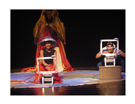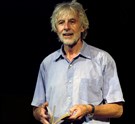The Kingdom of Women: Ein El Hilweh. Directed by Dahna Abourahme. Lebanon, 2010
Could I do today what I was able to do then, questions Nadia, one of the women in Dahna Abourahme’s latest documentary film The Kingdom of Women: Ein El Hilweh. Based on stories of the women of Ein El Hilweh, a Palestinian refugee camp in South Lebanon, between 1982-4 during the Israeli invasion and the imprisonment of the majority of the male population (those between the ages of 14-60), the film is also a reflection on the act of narration itself. The weaving of the women’s voices with tangible objects — letters from their husbands written from inside Israeli prisons, rich embroidery brought from Palestine by one of the women’s mothers, beaded jewelry made by another one of the women while in prison for her daughter — accompanies the juxtaposition of live documentary footage with animated scenes, old photographs, and newspaper clippings. The women draw out their stories from the objects, and via the animation and archival documents their stories of the camp during the Israeli invasion are reenacted. The layered narrations of the past in the present encourage us to read beyond a simplistic comparison between then and now.
Through Abourahme’s visual and conceptual framing, we see and hear seven women from the camp tell their stories from the spaces and places they created and inhabit today. The camera’s close-ups are largely reserved for the women’s hands, directing our eyes not just to the women themselves but to what they are capable of doing. About half-way into the film, we learn that those specific spaces in which we encounter the women were built by them, whether by physically making the cement, building the rooms, and painting the walls, or by strategically rebuilding their lives and the community through imaginative confrontations with Israeli soldiers and residents of the camp. Um Muhammad, for instance, turned her imprisoned husband’s taxi into a public vegetable stall to support her family in spite of local criticism. Halimeh creatively organized an orchestra of screaming children to force the Israeli army to relocate their presence from the roof of the pre-school to a neighboring building. And without any previous planning, the women’s use of collective cat-and-mouse tactics with Israeli soldiers led to the burning of tents that were being imposed on them as living quarters in the camp.
The use of animation in narrating the women’s stories plays on the dialogue between reality and imagination, not an imagination that is unrealizable but specifically one that has been enacted and can be reconfigured and learned from. For the animation is reserved for actions in the past, including the women’s hunger strikes in prison, the children’s orchestrated cries, and the women’s tactical burning of the tents, each succeeding in refusing and changing the behavior of the colonial, occupying power. Near the end of the film, Amal recalls a scene that she would never have imagined. Abla, her former school principal, is dancing on the table as Amal, detained by the Israelis, enters for the first time the Regie Detention Center for Women. While this particular moment is in response to the announcement of a prisoner exchange and their subsequent release, Abla speaks of the community among the women in the prison, their spirit and strength, as something to celebrate.
The multi-media layers of the film are therefore able to encapsulate the inspiration as well as the destruction. The opening animation sequence uses what Abourahme describes in an interview as a “raw simplicity” to visually narrate the historical context: Israel invades Lebanon, causing death and destruction; South Lebanon fights back. The Palestinian resistance is not an entity on its own; it is also the active participation of the women of Ein El Hilweh refugee camp, as it is the political cartoons of Naji al-‘Ali, whose drawings serve as the basis for the opening narrative sequence. Through his caricatures, Al-‘Ali, who was himself a resident of Ein El Hilweh and who was present in the camp during the Israeli invasion, offered a running commentary on events in the Arab world; his drawings resonate and maintain their powerful critique today, decades later. The juxtaposition of black-and-white animation (by artist Lena Merhej), documentary footage and photographs (the director of photography is Talal Khoury), and everyday sounds accompanied by a simple and poignant melody of distinctive notes (the original music is by Omar Khoury and Hatem Imam) weave together to narrate the women’s stories. For neither a linear narrative nor voices alone, as we learn from al-‘Ali’s caricatures, can capture the experience of Ein El Hilweh.
The refrain of “then” in the women’s narration, captured by such tactics of survival and challenge, is of a time when resistance was characterized by spontaneity and innovation. Amal, who now works with community programs to empower women, names a difference between then and now. During the invasion, she says, women would organize themselves without anyone telling them about their rights or what they were capable of doing on their own. The focus of the film’s narration upon a salient period in the past of the Palestinian refugee community in South Lebanon thus subtly and consciously directs our eyes to the present. For the issue is not that women are not capable of what they were in the past, but rather confronting the present context that frames what is to be desired, what is possible and what can be imagined.
“The film is an appreciation of what women do,” says Abourahme in her interview. “Their role was heightened in this narrative because their homes were destroyed and they needed to do what they did. . . . women have not changed but what did change is the way society views them.” What the film reveals is not just that then and now must be contextualized within their social and political environments locally and regionally, nor that such perceptions are always relative and never definitive. In addition, the film’s narrative structure allows us to reflect on the necessity and temporariness that enable the stepping out beyond social roles. The revolutions across the Arab world today show us yet again how the taking over of public spaces, workers on strike, and the people governing themselves in the streets, are put in the context of actions that are viewed as ‘acceptable’ (according to the logic of ‘business as usual’) precisely because they are temporary. The roles of Palestinian women in the first intifada in the occupied territories or those in Ein El Hilweh during the Israeli invasion arose out of ‘necessity’ and were therefore deemed socially acceptable. While the experiences of the women do not necessarily show us a different reality, the film’s narrative techniques gesture toward a potential reframing of Nadia’s question from “Could I do today what I was able to do then?” to: How do we create such a context to realize what we are capable of?
The film is part of a larger project organized by Al-Jana, Arab Resource Center for Popular Arts, to collect oral testimonies from Palestinian refugees that can serve to catalyze community solidarity and to enact change. In 2005, a group of women researchers came together in Al-Jana to begin to document the 1982-4 period, focusing on the role of women in the camp. The use of oral histories, as in Abourahme’s film, is not meant only for documentation purposes, however important that may be (especially considering Israel’s targeted destruction of Palestinian archives), but also for what the documents themselves can do. Al-Jana is clear in its aim of documenting the past in order to impact present understandings and future actions. A major contribution of the film is therefore the production of a narration that documents a particular moment in Palestinian history without limiting its resonance or impact on different audiences. The Kingdom of Women is not of the genre of films that frames resistance tactics as ‘non-violent’ in order to appease Western palates; instead, it builds on the layers of women’s narration to question a limited understanding of what constitutes a context of necessity and temporariness. A time that requires confrontation can also be framed as now and tomorrow, and what is deemed temporary can be elongated to include tomorrow, the day after, and so on. In other words, the context that enables the transgression of social roles and individual and collective capabilities need not be instigated by brutal oppression, but can emerge from local communities themselves.
“May those days be remembered but not repeated,” says Um Amer in the film. She speaks these words in the context of her husband’s long imprisonment and the costs of the Israeli invasion on the community as a whole. She speaks these words also in the context of the younger generation’s potential, despite their inexperience with the kind of liberation struggle that the women reminisced about in the film. What the animation invokes in us is not the longing to repeat or re-enact the past necessarily, but the desire to see our present actions animated, in other words, imaginative, confrontational, resonant. Commenting on the work of Palestinian writer Ghassan Kanafani, Barbara Harlow notes how his reconstructions and narrations of the past functioned as both interpretations of the present and visions for the future.[1] By recognizing the potential of the present, the desire is for now to be a period of empowerment and communal solidarity, to be documented for the scenes we will enact next.
For inquiries on the film, contact kingdomofwomen@al-jana.org.
![[Still image from \"The Kingdom of Women: Ein El Hilweh\"]](https://kms.jadaliyya.com/Images/357x383xo/400x300.jpg)










